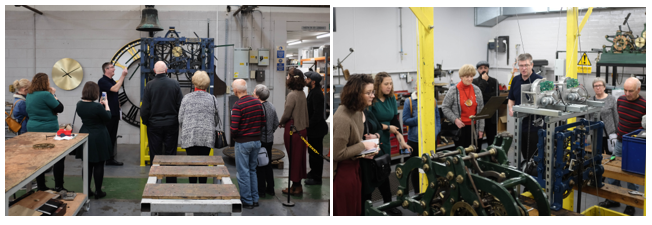This morning, volunteers from the Derby Museum of Making arrived for a tour of the clock works. After a short introduction from Managing Director Bob Betts, which touched on the history of the family company and its commitment to the future of clockmaking, Bob handed over to Customer Service Manager, Tony Charlesworth, who led the nine visitors on a tour of the factory.
Of particular note was the Harrison Clock. Tony outlined how Smith of Derby apprentices had been responsible for the dismantling, restoring and reassembly of the clock, and how the clock was back to full working order and ready for reinstallation in the Museum of Making at some point before its reopening in 2020.

The visitors enjoying a tour by Customer Service Manager Tony Charlesworth.
Among the visitors was Kalwinder Singh Dhindsa, author and teacher and long-term resident of Derby. “I’ve grown up in Derby”, he said, “and now work here and it’s exciting to see Smith of Derby, a company synonymous with Derby itself, continuing the work they have done for generations. Clocks give you a time and a place, clocks themselves and the memory of them can take you back in time. It’s sad when you see a clock somewhere and it’s stopped, as soon as a clock dies it’s not the same. Time is a beautiful thing and horology and it’s great to see your work here at Smith of Derby and how you are evolving and restoring clocks and keeping them alive.”
Joining Tony on the tour was also Nick Whitworth, 6th Generation of Smith Family, who enjoyed being reminded of what unusual and interesting company Smiths is when seen through new eyes. Nick remarked how “it’s great to be amongst those who are perhaps encountering the work we do for the first time. They asked lots of questions and were inquisitive and wanted to know how clocks worked and why they were the way they were. Of course, those of us connected with the company are proud of the work we do, the traditional and the cutting-edge, but it’s nice to share this feeling with others and to see that our work is prompting an enthusiastic response.”